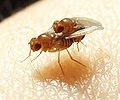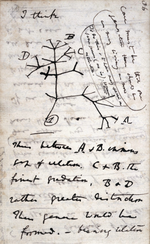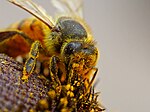In biology, coevolution occurs when two or more species reciprocally affect each other's evolution through the process of natural selection. The term...
49 KB (5,377 words) - 07:49, 8 January 2025
Bee (redirect from Coevolution of bees and flowers)
pollination, and are the most efficient pollinating insects. In a process of coevolution, flowers developed floral rewards such as nectar and longer tubes, and...
108 KB (10,897 words) - 16:58, 1 January 2025
CoEvolution Quarterly (1974–1985) was a journal descended from Stewart Brand's Whole Earth Catalog. Brand founded the CoEvolution Quarterly in 1974 using...
3 KB (220 words) - 19:17, 1 March 2024
Host–parasite coevolution is a special case of coevolution, where a host and a parasite continually adapt to each other. This can create an evolutionary...
26 KB (3,038 words) - 23:54, 11 April 2024
Sexual conflict (redirect from Sexually antagonistic coevolution)
Sexual conflict or sexual antagonism occurs when the two sexes have conflicting optimal fitness strategies concerning reproduction, particularly over the...
67 KB (8,685 words) - 21:33, 27 August 2024
Mosaic coevolution is a theory in which geographic location and community ecology shape differing coevolution between strongly interacting species in multiple...
6 KB (877 words) - 03:36, 16 December 2024
Escape and radiate coevolution is a hypothesis proposing that a coevolutionary 'arms-race' between primary producers and their consumers contributes to...
14 KB (1,853 words) - 08:55, 16 December 2023
Predation (redirect from Coevolution of predators and prey)
have been characterized as an evolutionary arms race, an example of the coevolution of two species. In a gene centered view of evolution, the genes of predator...
109 KB (11,580 words) - 07:39, 31 December 2024
Dual inheritance theory (redirect from Gene-culture coevolution)
Dual inheritance theory (DIT), also known as gene–culture coevolution or biocultural evolution, was developed in the 1960s through early 1980s to explain...
68 KB (8,249 words) - 19:00, 5 January 2025
figs, and tied wild fig fruits on to the cultivated trees. Overall, the coevolution of Ficus and wasps features Ficus being very specific as a host, combined...
10 KB (1,262 words) - 11:55, 3 December 2024
Polymorphism Genetic drift Gene flow Speciation Adaptive radiation Co-operation Coevolution Coextinction Contingency Divergence Convergence Parallel evolution Extinction...
69 KB (6,808 words) - 14:44, 9 December 2024
103H. doi:10.1038/ncomms1105. PMID 21045821. Brundrett, M. C. (2002). "Coevolution of roots and mycorrhizas of land plants". New Phytologist. 154 (2): 275–304...
140 KB (17,348 words) - 23:49, 15 November 2024
female reproductive tracts may also play a role in sexual antagonistic coevolution with males. In Drosophila species, a large group of enzymes known as...
15 KB (2,055 words) - 07:03, 14 June 2024
Cooperative Coevolution (CC) in the field of biological evolution is an evolutionary computation method. It divides a large problem into subcomponents...
4 KB (368 words) - 23:37, 15 November 2021
Prodoxidae (section Yucca moths and coevolution)
plant, cheating the yucca out of any benefits from this relationship. Coevolution is particularly important in evolutionary biology as it demonstrates...
12 KB (1,361 words) - 16:31, 6 June 2024
2005). "Coevolution and Pollination". University of Cincinnati. Archived from the original on 30 April 2009. Retrieved 9 May 2009. "Coevolution and Pollination"...
134 KB (12,796 words) - 01:44, 21 December 2024
perspective." The alternative view has been called "reflection-in-action," "coevolution" and "the action-centric perspective." The rational model was independently...
34 KB (3,499 words) - 15:32, 18 December 2024
Bee hummingbird (section Coevolution with flowers)
with the flowers that supply nectar is a notable example of bird–plant coevolution with its primary food source (flowers for nectar). Flowers that bee hummingbirds...
16 KB (1,439 words) - 02:13, 11 December 2024
multilevel selection theory regarding humans to another theory, gene–culture coevolution, by acknowledging that culture seems to characterize a group-level mechanism...
55 KB (6,215 words) - 17:51, 27 December 2024
Ecology (section Coevolution)
Ecology (from Ancient Greek οἶκος (oîkos) 'house' and -λογία (-logía) 'study of') is the natural science of the relationships among living organisms and...
210 KB (21,517 words) - 00:06, 21 December 2024
Parasitism (section Coevolution)
increased virulence. There are thus varied possibilities in host–parasite coevolution. Evolutionary epidemiology analyses how parasites spread and evolve,...
124 KB (12,592 words) - 09:21, 18 December 2024
Retrieved 12 October 2020. Lunau, Klaus (2004). "Adaptive radiation and coevolution — pollination biology case studies". Organisms Diversity & Evolution...
95 KB (8,073 words) - 13:56, 24 December 2024
Psyllid (section Coevolution)
Insect-plant interactions have been important in defining models of coevolution and cospeciation, referring to whether plant speciation drives insect...
10 KB (1,000 words) - 23:30, 10 November 2024
means. Venom is used as a trophic weapon by many predator species. The coevolution between predators and prey is the driving force of venom resistance,...
40 KB (4,283 words) - 08:31, 27 November 2024
Fig wasp (section Coevolution)
Fig wasps are wasps of the superfamily Chalcidoidea which spend their larval stage inside fig syconia. Some are pollinators but others simply feed off...
21 KB (2,048 words) - 22:03, 19 December 2024
Evolution (section Coevolution)
a means to enable continual evolution and adaptation in response to coevolution with other species in an ever-changing environment. Another hypothesis...
241 KB (25,087 words) - 00:47, 5 January 2025
leads both the predator and prey to come together at the same flowers. Coevolution of bees with the Australian crab spider has resulted in the spiders being...
26 KB (3,644 words) - 19:25, 27 June 2024
Pollinator Partnership (redirect from Coevolution Institute)
important pollinating species. The Pollinator Partnership was founded as the Coevolution Institute (CoE) in 1997. The early mission of the organization was to...
4 KB (399 words) - 12:39, 17 October 2024
Entomophily (section Coevolution)
some species also pollen baskets on their hind legs. This required the coevolution of insects and flowering plants in the development of pollination behaviour...
21 KB (2,350 words) - 21:27, 15 December 2024
Autumn leaf color (section Coevolution)
reabsorb nutrients (especially nitrogen) more efficiently. According to the coevolution theory, the colors are warning signals to insects like aphids that use...
28 KB (3,190 words) - 01:08, 28 October 2024





















